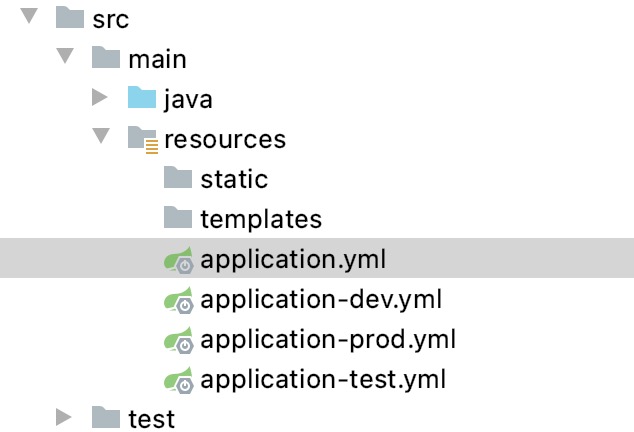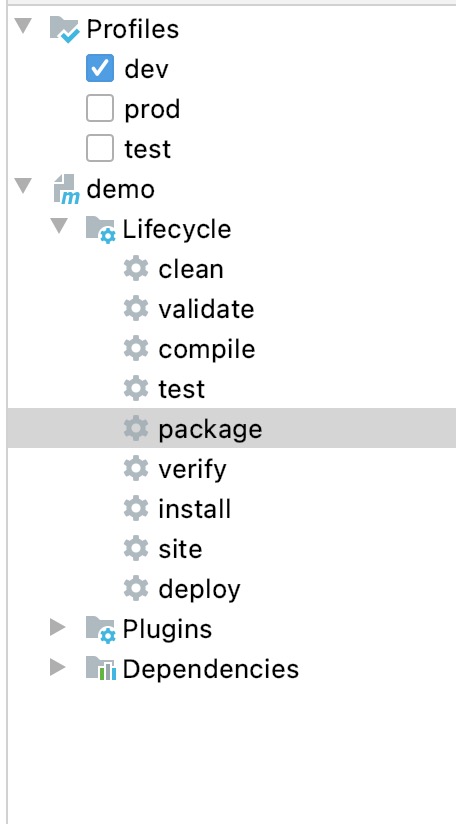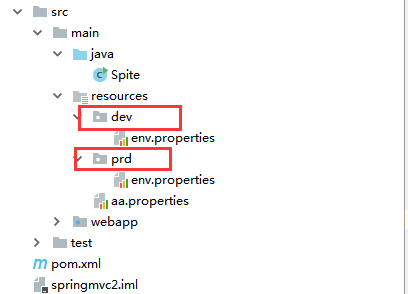maven中profiles使用
bbird2018 人气:0使用的场景
常常遇到一些项目中多环境切换的问题。比如在开发过程中用到开发环境,在测试中使用测试环境,在生产中用生产环境的情况。springboot中提供了 spring.profile.active的方式来实现多环境的切换,通过设置环境变量和启动参数的方式。但是这样做终究不能一劳永逸,要么需要修改yml文件,要么需要记得启动的时候带上参数。而利用maven的profiles,可以减少很多工作。让我们通过几个例子一步步的掌握使用maven的profiles属性。
快速上手
pom.xml文件设置
<profiles>
<profile>
<!--不同环境Profile的唯一id-->
<id>dev</id>
<properties>
<!--profiles.active是自定义的字段(名字随便起),自定义字段可以有多个-->
<profiles.active>dev</profiles.active>
</properties>
</profile>
<profile>
<id>prod</id>
<properties>
<profiles.active>prod</profiles.active>
</properties>
<activation>
<activeByDefault>true</activeByDefault>
</activation>
</profile>
<profile>
<id>test</id>
<properties>
<profiles.active>test</profiles.active>
</properties>
</profile>
</profiles>目录结构

application.yml
spring:
profiles:
active: @profiles.active@application-dev.yml中代码如下
server: port: 7091
其他几个文件我只是把端口号进行了修改,方便打包看不同的效果。
maven打包与激活profiles
你可以执行命令
mvn clean package -Ptest
然后启动jar包,可以看到jar包启动的是test的配置,如果换成-Pdev启动的就是dev包的端口。
默认启动方式
如果不带-Ptest,启动的是 prod的端口。因为在profiles中我们看到有配置默认的选项。
<activation> <activeByDefault>true</activeByDefault> </activation>
settings.xml中使用activeProfiles指定
<activeProfiles>
<activeProfile>profileTest1</activeProfile>
</activeProfiles> 通过IDEA的可视化的方式
当然如果使用IDEA工具进行开发,还可以使用可视化的方式进行打包。

更高级的玩法
通过和pom结合的方式设置动态参数
如果我们希望通过docker-maven-plugin插件,把编译好的jar打包成docker并且传入相应的开发、测试、生产的服务器中去。这个时候,我们就需要根据不同的条件去传入不同的服务器。
在profiles中我们可以做以下定义
<profiles>
<profile>
<id>dev</id>
<properties>
<profile.id>dev</profile.id>
<docker.host>http://dev.demo.com:2375</docker.host>
</properties>
<activation>
<activeByDefault>true</activeByDefault>
</activation>
</profile>
<profile>
<id>test</id>
<properties>
<profile.id>test</profile.id>
<docker.host>http://test.demo.com375</docker.host>
</properties>
</profile>
<profile>
<id>prod</id>
<properties>
<profile.id>prod</profile.id>
<docker.host>http://prod.demo.com:2375</docker.host>
</properties>
</profile>
</profiles>而在build控件中我们可以使用以下配置
<build>
<plugins>
<plugin>
<groupId>com.spotify</groupId>
<artifactId>docker-maven-plugin</artifactId>
<version>1.1.0</version>
<executions>
<execution>
<id>build-image</id>
<phase>package</phase>
<goals>
<goal>build</goal>
</goals>
</execution>
</executions>
<configuration>
<imageName>demo/${project.artifactId}</imageName>
<imageTags>
<imageTag>${project.version}-${current.time}</imageTag>
<imageTag>latest</imageTag>
</imageTags>
<forceTags>true</forceTags>
<dockerHost>${docker.host}</dockerHost>
<forceTags>true</forceTags>
<baseImage>java:8</baseImage>
<entryPoint>["java", "-jar", "/${project.build.finalName}.jar"]</entryPoint>
<resources>
<resource>
<targetPath>/</targetPath>
<directory>${project.build.directory}</directory>
<include>${project.build.finalName}.jar</include>
</resource>
</resources>
</configuration>
</plugin>
</plugins>
</build>其中 ${project.artifactId} 和${project.version}是关于节点下面和的引用。${current.time}是在build-helper-maven-plugin定义的,我们回头再研究。
${docker.host}则是我们在profiles中定义的,可以随着我们选择不同的profile,把jar包build成不同的docker镜像,并传入指定服务器。
通过和yml结合设置动态参数
除了可以在pom中设置动态参数,使得其根据profile的不同选择不同的参数。还可以通过设置不同的profile,让yml选择不同的参数。这点和快速上手的例子有点相似。具体如下:
设置profiles
<profiles>
<profile>
<id>dev</id>
<properties>
<profile.id>dev</profile.id>
<eureka.url>http://127.0.0.1:8001/eureka</eureka.url>
</properties>
<activation>
<activeByDefault>true</activeByDefault>
</activation>
</profile>
<profile>
<id>test</id>
<properties>
<profile.id>test</profile.id>
<eureka.url>http://base-registry:8001/eureka</eureka.url>
</properties>
</profile>
<profile>
<id>prod</id>
<properties>
<profile.id>prod</profile.id>
<eureka.url>http://base-registry:8001/eureka</eureka.url>
</properties>
</profile>
<profile>
<id>new</id>
<properties>
<profile.id>new</profile.id>
<eureka.url>http://base-registry:8001/eureka</eureka.url>
</properties>
</profile>
</profiles>我们在profile中设置了一个eureka.url的属性,就可以在yml中直接调用。
eureka:
client:
service-url:
defaultZone: @eureka.url@
registry-fetch-interval-seconds: 10
instance:
prefer-ip-address: true在IDEA调试和启动的时候,一般会报错如下:
org.yaml.snakeyaml.scanner.ScannerException: while scanning for the next token found character ‘@’ that cannot start any token.
解决方法就是引入yaml.sankeyaml的jar包
<dependency>
<groupId>org.yaml</groupId>
<artifactId>snakeyaml</artifactId>
</dependency>打包不同的资源
在profile打包yml文件的时候,如果我们解压了jar包,会发现还是把所有的application-profile.yml文件给打包进去了。这个可以通过设置打包参数,只打包需要的application文件。
<profiles>
<profile>
<id>dev</id>
<properties>
<env>dev</env>
</properties>
<activation>
<activeByDefault>true</activeByDefault>
</activation>
</profile>
<profile>
<id>prd</id>
<properties>
<env>prd</env>
</properties>
</profile>
</profiles>
<build>
<finalName>springmvc</finalName>
<resources>
<resource>
<directory>src/main/java</directory>
<includes>
<include>*.xml</include>
</includes>
</resource>
<resource>
<directory>src/main/resources</directory>
<excludes>
<exclude>dev/*</exclude>
<exclude>prd/*</exclude>
</excludes>
</resource>
<resource>
<directory>src/main/resources/${env}</directory>
</resource>
</resources>
</build>目录结构如下:

到此这篇关于详解maven中profiles使用实现的文章就介绍到这了,更多相关maven中profiles使用 内容请搜索以前的文章或继续浏览下面的相关文章希望大家以后多多支持!
加载全部内容